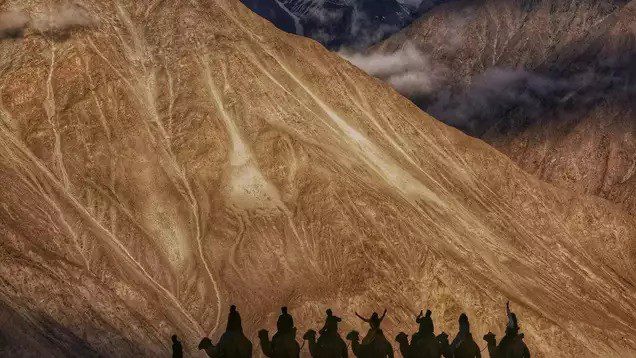Ladakh’s Ancient Trade Routes, nestled between the Himalayas and the Karakoram Range, showcase not only the breathtaking landscapes of the region but also its vital role in ancient trade. Ladakh’s strategic location made it a critical juncture on the legendary Silk Road, facilitating trade and cultural exchange between India, Tibet, and Central Asia for centuries. The history of these ancient trade routes not only shaped the economy of the region but also left a deep imprint on its culture, religion, and society.
In this article, we will explore Ladakh’s ancient trade routes, their significance in the Silk Road network, and their lasting influence on the region.
Introduction to Ladakh’s Role in the Silk Road Trade
Ladakh, often referred to as the “Land of High Passes,” is geographically positioned at the crossroads of several ancient trade routes. It connected the Indian subcontinent to Tibet, Central Asia, and even beyond, through the vast Trans-Himalayan trade network. Due to its high altitude and rugged terrain, Ladakh was a challenging route, but its importance in the Silk Road trade made it an indispensable part of this ancient global network.
Merchants traveling through Ladakh traded silk, spices, wool, and precious stones, linking different civilizations in a web of commerce and cultural exchange. From the 2nd century BCE to the 14th century CE, the Silk Road routes that passed through Ladakh became vital arteries for economic and cultural flows.
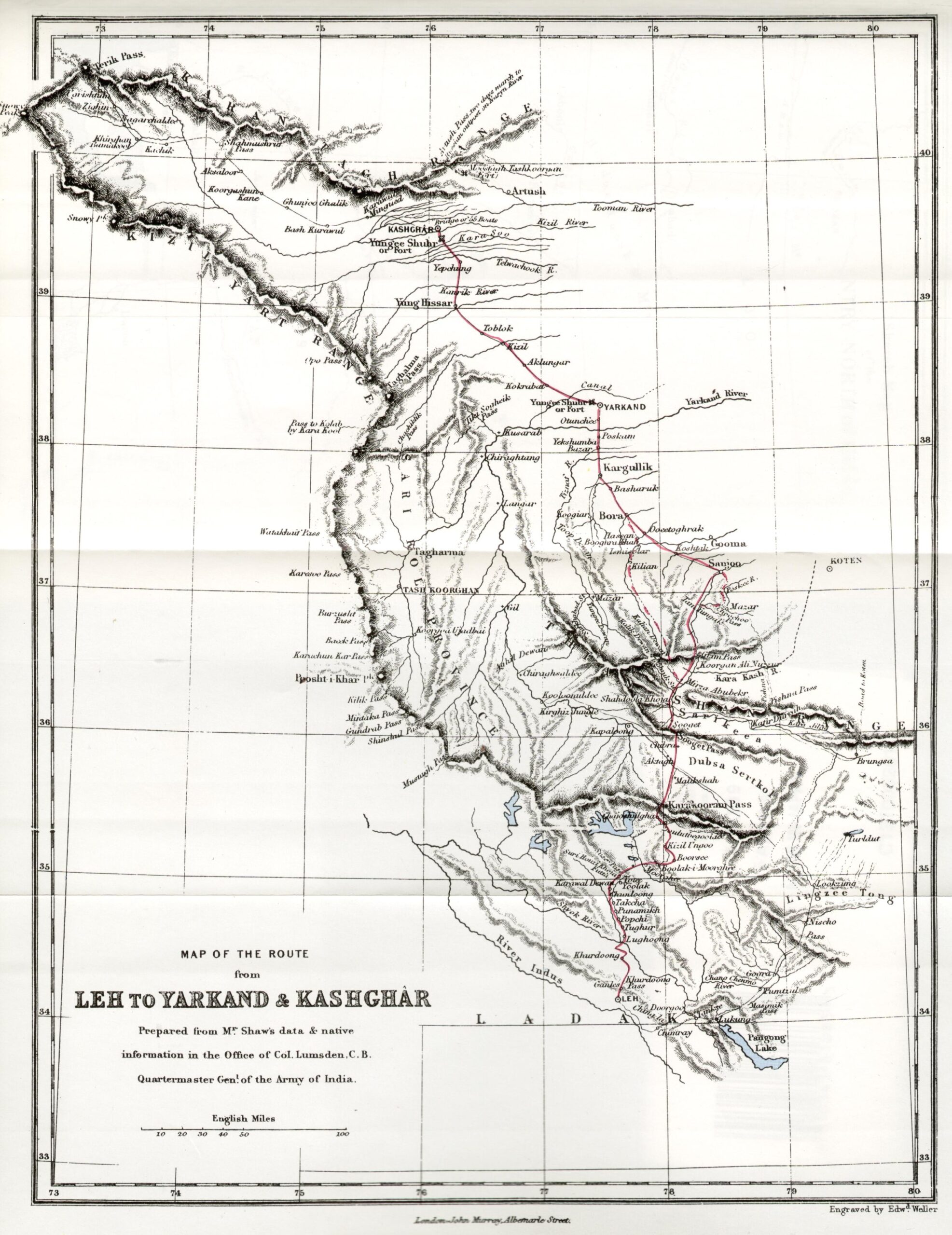
The Importance of Ladakh’s Ancient Trade Routes
Trans-Himalayan Trade Networks and Caravan Routes
Ladakh’s location along the Trans-Himalayan trade routes was crucial for merchants traveling between Central Asia and the Indian subcontinent. These ancient trade networks were not just limited to material exchange but also played a significant role in the exchange of ideas, religions, and cultures.
Caravans of yaks, camels, and horses traversed these routes, laden with goods such as Chinese silk, Indian spices, and Tibetan wool. Ladakh was especially known for its salt, sourced from its lakes, which was a valuable commodity traded across the region.
Leh: Ladakh’s Historical Trade Hub
Leh, the capital of Ladakh, emerged as a significant trade hub during the height of the Silk Road era. Situated at an altitude of 3,500 meters, Leh’s central location made it a gathering point for traders from Tibet, China, India, and Central Asia. The bustling bazaars of Leh were filled with goods from across the world, and it became a melting pot of cultures, languages, and religions.
The prosperity of Leh as a trading center attracted not only traders but also Buddhist monks, scholars, and craftsmen, contributing to Ladakh’s cultural richness.
How Goods Like Silk, Spices, and Precious Stones Moved Across the Region
The Silk Road was named after the lucrative trade in silk that originated in China. However, the goods traded through Ladakh were far more diverse. Merchants carried precious stones from Central Asia, spices from India, and wool and salt from Tibet.
The trade routes that passed through Ladakh facilitated not just the exchange of goods, but also the movement of knowledge, technology, and religious beliefs. For example, Buddhism spread to Ladakh from India via these routes, and the region became a key center for the religion.
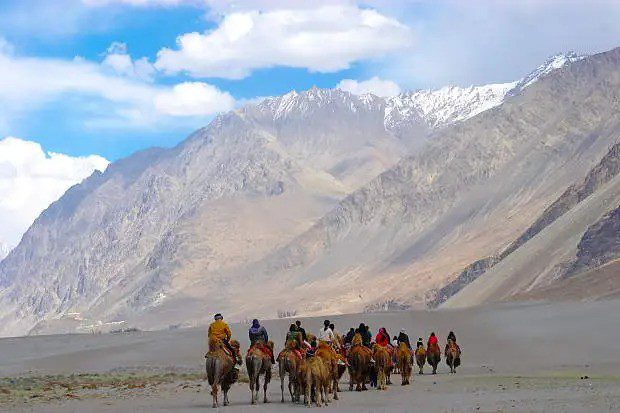
The Cultural Exchange Along Ladakh’s Trade Routes
Spread of Buddhism Through Ladakh and Along the Silk Road
The Silk Road was not just a network of trade routes; it was also a conduit for the spread of religion and ideas. One of the most significant impacts of the Silk Road on Ladakh was the spread of Buddhism. As traders and travelers from India moved into Tibet and Central Asia, they brought Buddhist teachings with them. Ladakh, due to its proximity to both Tibet and India, became a major center of Buddhism.
Buddhist monasteries began to flourish along the trade routes, particularly in Leh and its surrounding areas. These monasteries became important centers of learning and pilgrimage, further solidifying Ladakh’s role as a cultural and religious hub.
Influence of Central Asian Traders on Ladakhi Culture
The influence of Central Asian traders on Ladakhi culture is evident in various aspects of life in the region, from its architecture to its cuisine. For instance, the use of dried fruits and nuts, a staple of Central Asian diets, became common in Ladakhi food. Similarly, the architectural style of Ladakh’s buildings, with their flat roofs and intricately designed courtyards, reflects a blend of Tibetan and Central Asian influences.
Ladakh’s unique position on the Silk Road allowed for a fascinating fusion of cultures, which is still visible in the region’s festivals, clothing, and religious practices.

The Silk Road’s Key Trade Routes Through Ladakh
Ancient Caravan Routes Crossing the Karakoram Pass
One of the most significant passes for trade through Ladakh was the Karakoram Pass, which connects India to Central Asia. This high-altitude pass, over 5,500 meters above sea level, was treacherous and challenging, but essential for the caravans that carried goods between China, Central Asia, and India.
Other important passes that were part of Ladakh’s trade routes include the Zoji La, which connected Ladakh to Kashmir, and the Khardung La, one of the highest motorable passes in the world today. These passes were vital corridors for the movement of both goods and people.
Mountain Passes That Connected India, China, and Central Asia
In addition to the Karakoram Pass, the ancient Silk Road through Ladakh included several other key mountain passes. The Zoji La pass, for example, played a significant role in linking Ladakh to the rest of India, allowing traders to bring goods such as spices and textiles from the plains to the high-altitude regions of Central Asia.
While many of these routes are now modern highways, they still retain the essence of their ancient importance, serving as a reminder of Ladakh’s crucial role in global trade.
Nomadic Traders and Historic Caravanserais in Ladakh
Throughout history, the trade routes of Ladakh were frequented by nomadic traders who lived off the land and traveled with their goods. These traders, often part of larger caravans, would rest in caravanserais, or roadside inns, which provided shelter and food for merchants and their animals. Some of these ancient caravanserais still exist in ruins today, offering a glimpse into the lives of the merchants who once traversed these rugged routes.
Leh Palace and Ancient Trading Posts in Ladakh
Role of Leh Palace in Facilitating Trade
Leh Palace, a stunning 17th-century structure overlooking the city, played a central role in the administration and facilitation of trade in the region. Built by King Sengge Namgyal, the palace served as the royal residence, but its strategic position also allowed the king to oversee the trade routes passing through Leh.
The palace’s design, which mirrors the famous Potala Palace in Lhasa, reflects Ladakh’s deep connections with Tibet, further underscoring its role as a crossroads of cultures and trade.
Trading Hubs and Markets That Sprang Up Around the Silk Road
Markets in Leh and other parts of Ladakh became bustling centers of trade activity. Goods from India, Tibet, and Central Asia were exchanged in these markets, creating a vibrant economy. Today, many of these ancient trading posts have been preserved, and they continue to attract visitors interested in Ladakh’s rich trade history.
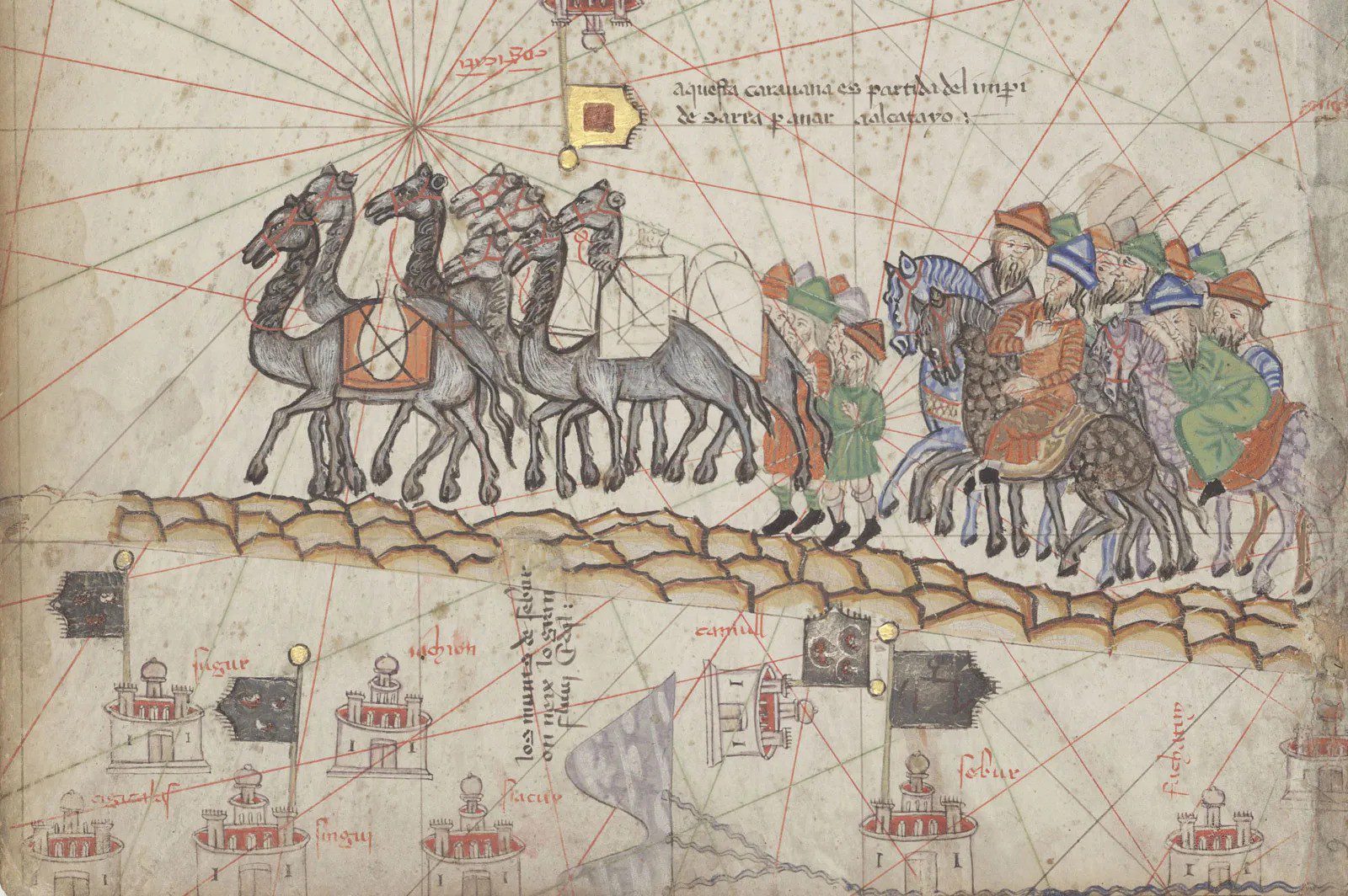
Goods Traded Along Ladakh’s Ancient Silk Road
Precious Goods: Silk, Spices, Salt, and Wool
The Silk Road through Ladakh facilitated the trade of a wide variety of goods. From China came silk and porcelain; from India, spices and textiles; and from Tibet, salt and wool. These goods were carried by traders on long, arduous journeys across the high-altitude passes of the Himalayas.
Ladakh was particularly famous for its salt, which was harvested from its high-altitude lakes and traded as far as Central Asia. Wool from Ladakh, known as pashmina, was also a highly sought-after commodity, especially in regions where it was too warm to raise sheep.
Historic Trade Relationships Between Ladakh, Tibet, and Central Asia
The trade routes that passed through Ladakh not only facilitated commerce but also fostered diplomatic relationships between regions. Ladakh maintained strong trade ties with Tibet, Central Asia, and the Mughal Empire in India, benefiting from its position as a gateway between these powerful regions.
Silk Road Tourism in Modern Ladakh
Exploring Ancient Trade Routes as a Tourist
Today, visitors to Ladakh can trace the footsteps of ancient merchants by traveling along the same routes that once formed part of the Silk Road. Adventurers can explore the high-altitude passes, visit ancient monasteries, and see the remnants of caravanserais that dot the landscape.
Ladakh’s Cultural Heritage Sites Along the Silk Road
Many of Ladakh’s cultural heritage sites, such as Hemis Monastery and Thiksey Monastery, are located along these ancient trade routes. These monasteries, some of which date back to the early centuries of Buddhism in Ladakh, offer insight into the religious and cultural life of the region during the height of the Silk Road era.
Visiting Historic Caravanserais and Trade Markets Today
Travelers can still visit the ruins of ancient caravanserais and explore markets that were once bustling with trade. In places like Leh, the legacy of these ancient trade routes continues to live on, with the local economy still benefiting from tourism and the sale of traditional Ladakhi goods like woolen garments and handicrafts.
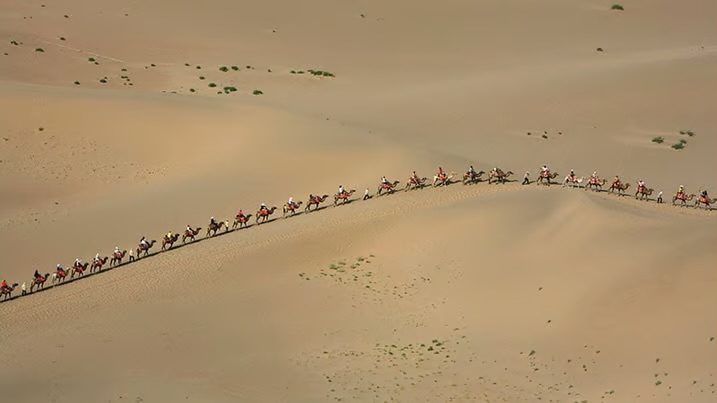
Conclusion: Ladakh’s Enduring Legacy as a Trade Hub
Ladakh’s ancient trade routes were much more than just pathways for commerce. They were conduits for the exchange of ideas, religion, and culture, shaping the region into the unique melting pot it is today. The legacy of the Silk Road is still visible in Ladakh’s culture, its festivals, and its architectural heritage.
As modern travelers retrace the routes once taken by ancient caravans, they not only explore the stunning landscapes of Ladakh but also connect with a history that spans centuries.
Frequently Asked Questions (FAQs)
What was the importance of Ladakh on the Silk Road?
Ladakh was a key transit point on the Silk Road, connecting India, Tibet, and Central Asia. It facilitated the exchange of goods like silk, spices, and wool while fostering cultural and religious exchange.
What goods were traded on Ladakh’s ancient trade routes?
Key goods included silk from China, spices from India, salt from Tibet, and wool from Ladakh. Precious stones and textiles were also traded extensively.
How did the Silk Road influence Ladakh’s culture?
The Silk Road brought traders, monks, and scholars from across Asia to Ladakh, influencing its architecture, cuisine, and religious practices, particularly the spread of Buddhism.
What are the major mountain passes used for trade in Ladakh?
The Karakoram Pass, Zoji La, and Khardung La were major passes that facilitated trade through Ladakh. These routes connected India to Tibet, Central Asia, and China.
Can you visit historic Silk Road routes in Ladakh today?
Yes, tourists can explore many of the ancient trade routes, caravanserais, and cultural heritage sites along Ladakh’s Silk Road routes.
Sources
- Snellgrove, David. Cultural History of Ladakh: Trade and Culture Across the Himalayas. Oxford University Press, 2005.
- Rizvi, Janet. Ladakh: Crossroads of High Asia. Oxford University Press, 1998.
- Francke, A. H. A History of Ladakh: From the Earliest Times to the Present Day. Vintage Books, 2009.

